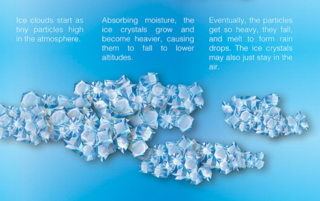Space Station Info :: Research and Technology
Tiny Satellite's First Global Map of Ice Clouds
Looking at Earth from the International Space Station, astronauts see big, white clouds spreading across the planet. They cannot distinguish a gray rain cloud from a puffy white cloud. While satellites can see through many clouds and estimate the liquid precipitation they hold, they can't see the smaller ice particles that create enormous rain clouds.
An experimental small satellite has filled this void and captured the first global picture of the small frozen particles inside clouds, normally called ice clouds. Deployed from the space station in May 2017, IceCube is testing instruments for their ability to make space-based measurements of the small, frozen crystals that make up ice clouds. "Heavy downpours originate from ice clouds," said Dong Wu, IceCube principal investigator at NASA's Goddard Space Flight Center in Greenbelt, Maryland.
Ice clouds start as tiny particles high in the atmosphere. Absorbing moisture, the ice crystals grow and become heavier, causing them to fall to lower altitudes. Eventually, the particles get so heavy, they fall and melt to form rain drops. The ice crystals may also just stay in the air. Like other clouds, ice clouds affect Earth's energy budget by either reflecting or absorbing the Sun's energy and by affecting the emission of heat from Earth into space. Thus, ice clouds are key variables in weather and climate models. The brightest peak areas represent the largest concentration of ice clouds. They reach up to the top of the troposphere from deep convection, which is normally strongest in the tropics. IceCube charges its batteries when the Sun shines on its solar arrays.
Measuring atmospheric ice on a global scale remains highly uncertain because satellites have been unable to detect the amount of small ice particles inside the clouds, as these particles are too opaque for infrared and visible sensors to penetrate. To overcome that limitation, IceCube was outfitted with a submillimeter radiometer that bridges the missing sensitivity between infrared and microwave wavelengths. Despite weighing only 10 pounds and being about size of a loaf of bread, IceCube is a bona fide spacecraft, complete with three-axis attitude control, deployable solar arrays and a deployable UHF communications antenna. The CubeSat spins around its axis, like a plate spinning on a pole. It points at Earth to take a measurement then looks at the cold space to calibrate.
"The hard part about developing the CubeSat is making the commercial parts durable in space," said Tom Johnson, Goddard's Small Satellite manager stationed at NASA's Wallops Flight Facility in Virginia. "We bought commercial components for IceCube and spent a lot of time testing the components making sure each part worked." While the IceCube team planned for the mission to operate for 30 days in space, "It does not cost very much to keep it going," Johnson said, "so we extended the mission due to the outstanding science that IceCube is performing. We download data eight to 10 times a week. Even if we miss a week, the CubeSat can hold a couple of weeks of data." The IceCube team built the spacecraft using funding from NASA's Earth Science Technology Office's (ESTO) In-Space Validation of Earth Science Technologies (InVEST) program and NASA's Science Mission Directorate CubeSat Initiative. Small satellites, including CubeSats, are playing an increasingly larger role in exploration, technology demonstration, scientific research and educational investigations at NASA.


